INTERMEDIATE TECHNOLOGY GROUP
ITDG 5: SUSTAINABLE COOKING
Sources of energy in Sri Lanka
Finding a sustainable source of energy, especially for cooking
is a major concern for the majority of the population in
Sri Lanka. Biomass energy (plant materials, including wood,
and animal waste used for fuel) is used by more than 80%
of the population. Research suggests that although other
forms of energy are slowly becoming available, biomass will
remain the main source of energy for the poor.
At the start of the 21st century the average consumption per
person in Sri Lanka was about 1.3kgper day, whilst in colder
and hilly areas it went up to 2.5 kg. The total national consumption
is estimated to be about 10 million tons annually. Although
there is a variety of potential sources of biomass (coconut
plantations, forest, crop land, processing waste and home gardens),
firewood is used a great deal. There are alternatives, kerosene
and liquid petroleum gas, but these are often beyond the income
of poorer families who can usually find firewood or alternative
biomass sources freely available. It is estimated that 10%
- 15% of the firewood comes from forests or cotton and tea
plantations, home gardens and crops. Packs of
firewood are sold in shops and by the roadside. They cost around
50 rupees (about 35p).
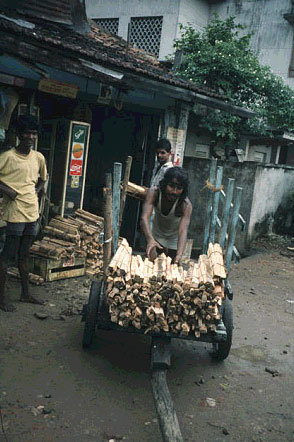
Selling firewood in a local store.
Problems with biomass collection
Reliance on biomass creates issues both environmentally and
socially. Demand for firewood means a constant search for
good sources which means loss of forest with consequent environmental
and climate changes.
It is usually Sri Lankan women who take responsibility for
the collection of biomass. This takes time and means their
ability to do other more productive roles is severely restricted.
When there are shortages, the problem becomes more acute. They
have to travel longer distances to collect firewood, or they
reduce the number of meals cooked, or they use lower quality
(e.g. wet) biomass for cooking. Sometimes, they ask school-age
children to collect instead, or go into prohibited areas in
search of wood. At times of shortage, they are also likely
to stop any income-generating activities (e.g. making curd)
in order to concentrate on keeping the family properly fed,
which means collecting firewood daily.
The process of collecting is in itself sometimes hazardous.
There is reduced infant and child care, possibility of snake
or insect bites, severe tiredness and allergies from fungi
in the forests.
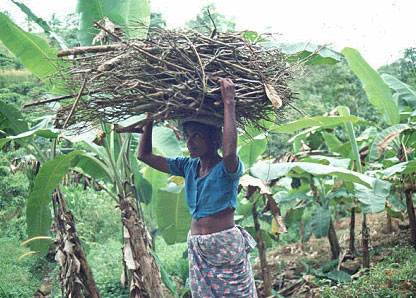
A typical Sri Lankan scene - a woman collecting firewood
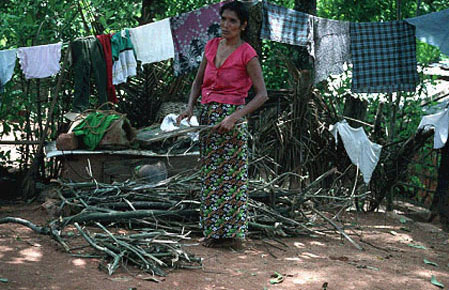
A
Sri Lankan woman with about two days’ supply of
firewood for use in her home.
Problems with using firewood as an energy source
It is not just the supply of biomass that creates problems
for families, especially women. Using biomass, especially
indoors, creates health hazards. Fires are usually located
in the kitchen, the heart of family life where children and
women spend most of their time. Smoke is a major problem.
Since the fires have no hoods, and often the kitchens have
poor ventilation, respiratory problems, conjunctivitis, bronchitis,
pulmonary diseases and even cancer are potential outcomes.
The fires themselves are also hazardous. They are often at
ground level and therefore easily accessible to small children,
making burns an obvious problem. Crouching to attend the fires
also leads to back problems.
Finally, there is the question of loss of forests. Because
demand is so high, and the most common type of fire is an open
three-stone fire, there is considerable waste of energy through
the difficulty of controlling the heat in an open fire.
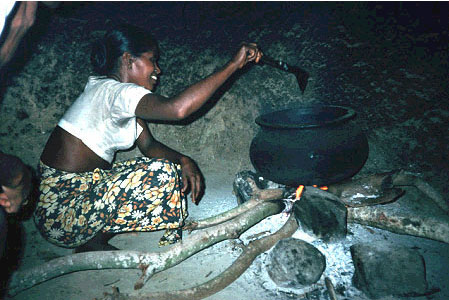
A traditional three stone fire in use in a Sri Lankan home
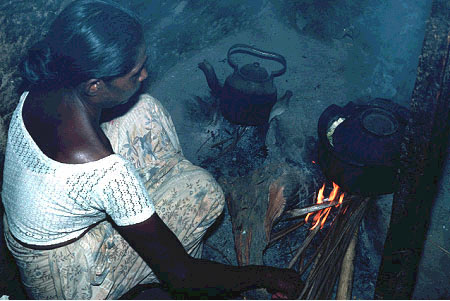
Three stone fires have their limitations and result in smoke
and burn hazards.
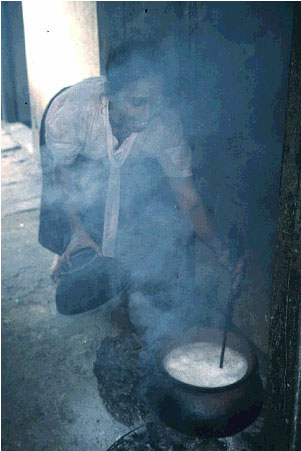
Cooking rice on a three stone fire.
The three stone fire
By far the most traditional method of cooking is on the three
stone fire. It is also by the cheapest. All you need are three
suitable stones of the same height on which your cooking pot
can be balanced. The problems are obvious
• smoke and steam can cause health problems
• balancing the pot is vital
• only one pot can be used at a time
• there is no heat control
• it is easy for accidents to happen
• fuel is wasted
• attending to the pot and adding fuel both require bending
There are advantages for most people in using the three stone fire and any new
stove needs to consider the following points
•
It is convenient
•
It involves NO cost at all
•
It can cope with a wide range of pot sizes and shapes
•
It heats the kitchen area in cold weather
•
The smoke is used to process food e.g. fish, meat and cereals to give a longer
life.
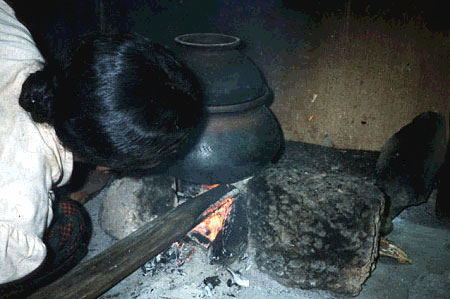
Tending a three stone fire.
Other existing methods
People in Sri Lanka have been developing improved fires in
a bid to cut down fuel waste and health and safety hazards.
They have had considerable success. One of the improvements
is the Anagi stove, developed to reduce the quantity of biomass
needed, to enable two pots to be used at once, and to cut
down health risks.
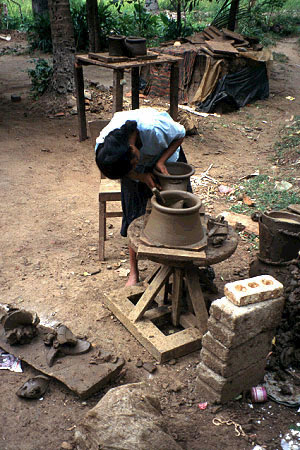
A Sri Lankan potter at work making an Anagi stove
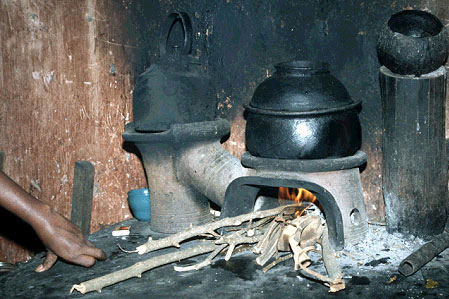
An Anagi stove in use
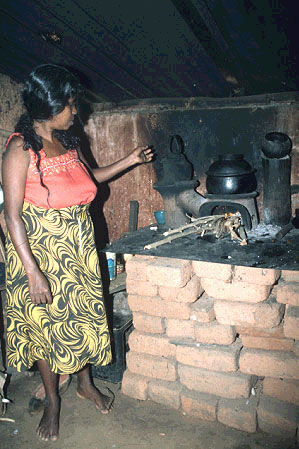
A raised Anagi stove
It has been estimated that the Anagi stove results in a 50%
reduction in biomass usage. As a result it has become very
popular with all classes of people, especially when the price
of liquid petroleum gas or kerosene has risen.
Continuing issues
Although the Anagi stove improved life for many Sri Lankan
households there are still some areas where people are looking
to improve its design or develop a new type of stove. Some
of the areas suggested by Dr Amerasekara, the Director of
Integrated Development Association, A Sri Lankan non-government
organisation working with Sri Lankan people are
•
a stove capable of being used with larger pots suitable for
use by small scale street traders
•
a stove capable of coping with a wider variety of sizes and
shapes - current stoves can use stoves of between 20
and 50 cm diameter and usually manage round-bottomed pots more
safely than flat-bottomed
•
some kind of hood or chimney to take the smoke and steam away
from the kitchen or area where it is being used
•
investigating other sources of fuel to replace wood, especially
if it was waste products from other kinds of work
•
a more permanent installation - free standing stoves
may only last one year whereas installation extends life to
five years
•
developing a simple stand allowing people to work at the correct
height rather than constantly bending or crouching.
What would be the specification for an improved stove?
•
Cost is critical. Most current stoves sell for around 100 rupees.
(150 rupees = £1) A loaf of bread sells for about 10
rupees in a Sri Lankan market.
•
Something for a small street industry would need to be made
for less than 1000 rupees
•
Able to support pots with a capacity of 100 litres of liquid.
•
Capable of supporting a variety of different shaped and sized
pots.
•
Capable of adapting for either internal or external use.
•
Includes a method of smoke extraction for the kitchen.
•
Able to use at least two pots simultaneously.
•
Uses locally available materials, preferably clay, since this
is the cheapest material widely available in Sri Lanka. Metal
is also available.
•
Draught is also very important - the design would need
to generate enough heat, especially for use in a domestic industry.
|









